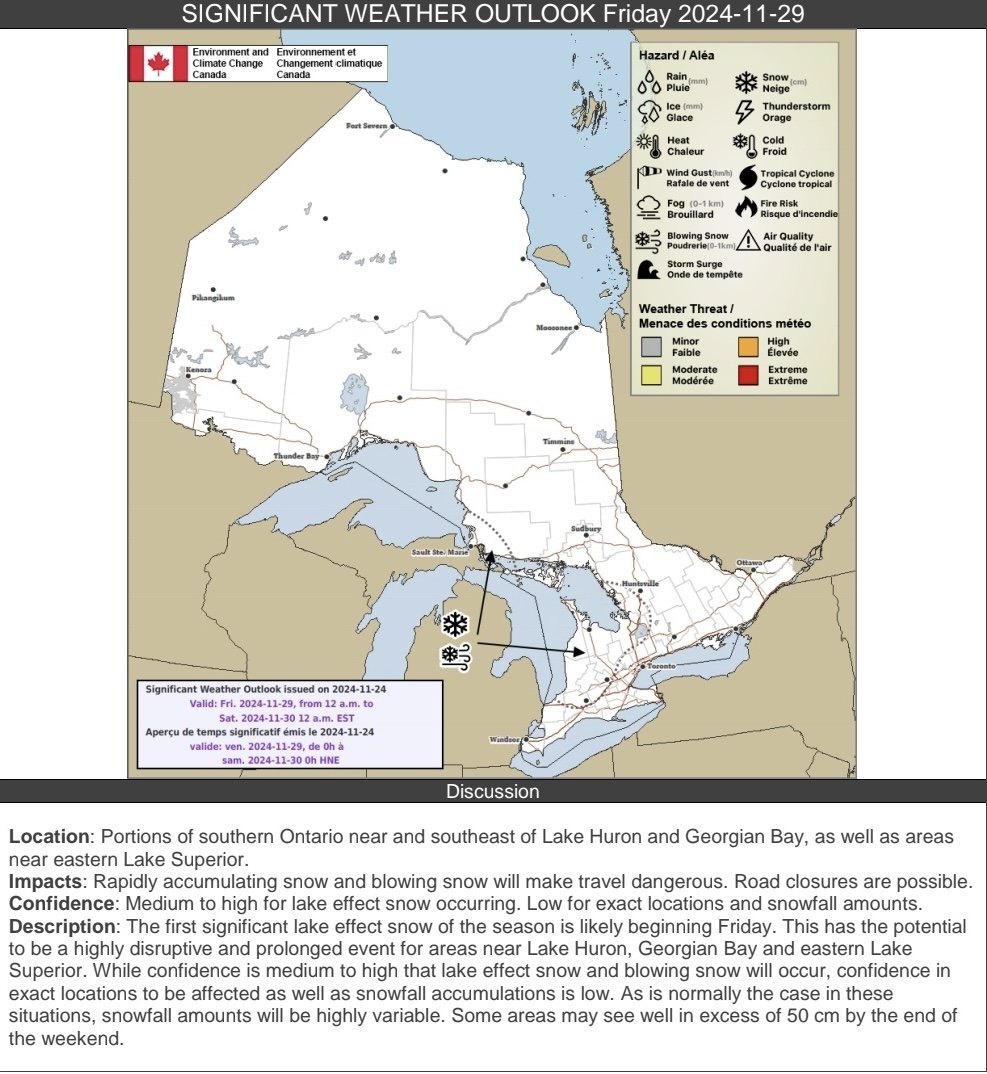Snow Squalls Continue to Paralyze Ontario’s Snowbelt With Another 25-50cm of Snow by Monday
/It may have been a slow start to the winter season across Southern Ontario, but November is certainly ending with a bang. Above-average lake temperatures have fueled intense lake-effect snow squalls that have pummeled the snowbelt regions over the past few days.
As of Saturday evening, some of the hardest-hit areas, including Bracebridge, Gravenhurst, and Hanover, have reported snowfall totals ranging from 50 to 100 cm, with localized pockets even exceeding the 100 cm mark! This has led to massive issues on the roads as dozens of drivers were left stranded on Hwy 11 south of Gravenhurst due to extreme snowfall accumulation.
But the snowy barrage is far from over for these regions. By the time the squalls wind down late Monday, an additional 25 to 50 cm of snow could accumulate around areas east of Lake Huron and Georgian Bay.
Currently, intense snow squall activity is ongoing east of both lakes, with a focus on the Bala-to-Bracebridge corridor and the Tiverton-to-Walkerton stretch. These squalls are expected to remain mostly stationary overnight, with snowfall rates reaching 5 to 10 cm per hour. This could add another 25 to 50 cm of snow in already heavily affected areas by Sunday morning.
By Sunday morning, a shift in wind direction is anticipated, pushing the squalls further south. The Georgian Bay squall will likely bring a quick but intense blast of snow to Midland, Orillia, and Barrie. Meanwhile, the squall near Hanover is expected to dissipate by late morning, only to be replaced by a more robust squall moving in from the north, targeting Owen Sound and Kincardine.
PRECIPITATION TYPE - MAP FROM WEATHERBELL
This northern squall could stretch far enough inland to reach areas like Orangeville and perhaps even the Greater Toronto Area (GTA) by mid-afternoon. Although it won't last long enough to produce significant accumulation, it could lead to a sudden reduction in visibility and a quick 2 to 5 cm of snow. Similarly, Kitchener and Guelph may experience a few hours of heavy snow as the squall moves through.
PRECIPITATION TYPE - MAP FROM WEATHERBELL
By Sunday evening, the squalls are expected to settle southeast of Georgian Bay and Lake Huron. Collingwood and Meaford are likely to find themselves in the crosshairs of the Georgian Bay squall, while the Lake Huron squall will stretch from Goderich along the shoreline to Grand Bend and inland towards areas north of London.
According to the latest model data, the Georgian Bay squall may remain closer to the shoreline, potentially sparing Barrie and the Hwy 400 corridor from the heaviest snow.
However, London might not be as fortunate. The Lake Huron squall could extend into the city at times during the overnight hours and into early Monday. That said, the most intense snowfall rates are expected to stay north of London, impacting areas like Exeter, St. Marys, and Stratford.
Snow squall activity will persist throughout Monday and possibly into the overnight hours before tapering off late Tuesday morning. This will coincide with the arrival of a system from the west that could bring more widespread snowfall to parts of Southern Ontario. Details on that system will be shared in a separate forecast.
As is typical with snow squalls, snowfall totals will vary significantly depending on where the squalls settle. There is high confidence that regions in Muskoka and along much of the eastern Lake Huron shoreline will see an additional 25 to 50 cm of snow on top of what has already fallen.
Northwest of London, models indicate the Lake Huron squall could stall over the area from Sunday evening through Tuesday morning, potentially leading to localized totals exceeding 50 cm. Confidence in this scenario remains low, so we’ve held off from including it in our snowfall map for now.
The City of London is forecast to receive 15 to 25 cm of snow from the southern tip of the Lake Huron squall. However, there is potential for slightly higher totals depending on how far the squall extends inland.
The southern shoreline of Georgian Bay, including Collingwood and Meaford, is expected to see 25 to 50 cm of snow, with higher amounts likely in elevated areas such as Blue Mountain—great news for ski enthusiasts!
Simcoe County, including Barrie and Orillia, is forecast to receive lesser amounts, with 5 to 15 cm (possibly up to 20 cm) expected during the morning and afternoon hours on Sunday. Kitchener and Woodstock could also see 5 to 10 cm of snow from the Lake Huron squall.
Outside these core regions, snowfall will be minimal, with most areas receiving less than 5 cm. We are keeping an eye on the southern Niagara region and Prince Edward County, which could potentially be grazed by snow squall activity that is currently expected to remain south of the border. If it does drift north, localized totals of 5 to 10 cm could develop in areas like Fort Erie, Port Colborne, and Picton.








































































